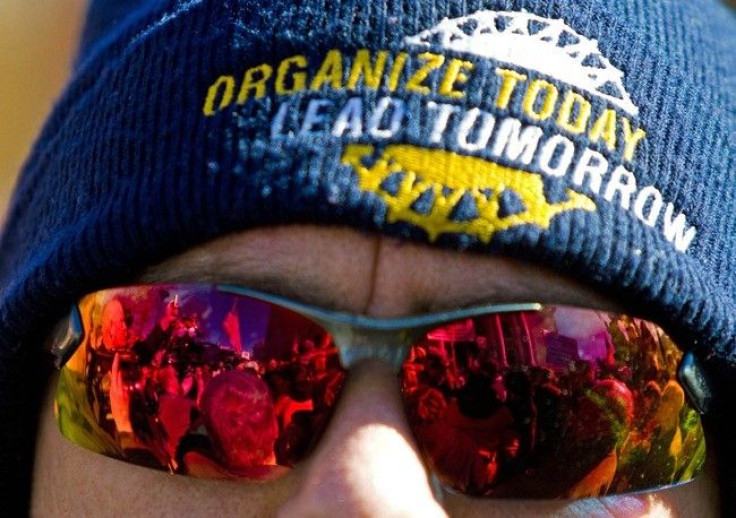Does Right to Work Create Jobs? Experts Aren’t Sure

After Indiana's General Assembly passed a highly contentious right-to-work law this week, Republican House Speaker Brian Bosma triumphantly declared the state open for business.
Supporters argued that making Indiana a right-to-work state would encourage businesses to relocate there. The law prohibits unions from requiring non-union workers from paying union fees, weakening unions and diminishing their ability to negotiate higher wages and benefits for workers.
A study commissioned by the Republican-controlled Indiana General Assembly found that employers preferred right-to-work because it confers more flexibility and lower hiring costs. To Democrats who stridently opposed the new law, that's essentially a euphemism for employers saving money on wages and benefits.
What did they fight for? Indiana House Minority Leader Patrick Bauer, a Democrat, said after the bill passed. They fought for less pay, less workplace safety and less health care. This is their only job plank: job creation for less pay with the so-called 'right- to-work' for less bill.
But a survey of available data suggests the link between right-to-work and job creation is not so clear. While some right-to-work states have outpaced non right-to-work states in manufacturing job growth, it's difficult to know whether those gains are the result of right-to-work laws or other factors.
A paper by Thomas Holmes, economics professor at the University of Minnesota, studied adjacent counties in right-to-work states and non right-to-work states and found that right-to-work counties tended to produce more manufacturing jobs. But he also noted that right-to-work laws also tended to accompany a constellation of other pro-business policies.
Right-to-Work states historically have pursued a number of other smokestack-chasing policies, such as low taxes, aggressive subsidies, and even, in some cases, lax environmental regulations, Holmes wrote. Thus, my results do not say that it is right-to-work laws that matter, but rather that the 'pro-business package' offered by right-to-work states seems to matter.
Right-to-work laws proliferated in the South after the federal Taft-Hartley Act, passed by a Republican U.S. Congress in 1947 over the veto of Democratic President Harry Truman, permitted them. Although manufacturing thrived in many of those states, Holmes identified a number of other factors that made the region ripe for growth: Its underdeveloped manufacturing sector had plenty of space to grow, exploding agricultural productivity created a huge base of suddenly obsolete farm workers who readily took jobs in manufacturing and better transportation networks like the Interstate Highway System helped move materials. The advent of air conditioning made manufacturing hospitable.
The real trouble you have in studying this empirically is that right-to-work is not a natural experiment, said Michael Hicks, director of Ball State University's Center for Business and Economic Research, in Muncie, Ind., in an interview. The states that have mostly passed right-to-work and had it instituted are states that had a very long anti-union antipathy, and the same southern states that had this pervasive anti-union culture up through recent times also tended to have lower business tax rates.
Hicks said he believes the new law is unlikely to have a significant effect on Indiana's manufacturing sector. The state's robust transportation system and relatively low taxes and labor costs already make it attractive to businesses, a situation that right-to-work likely wouldn't alter, he added.
There's also wide variation in how right-to-work states perform. A study by the liberal Economic Policy Institute found that between 2000 and 2009 right-to-work Arizona saw 19 percent employment growth while right-to-work Alabama saw its employment shrink by 5 percent. Non right-to-work New Mexico boasted an 8.2 percent growth rate that outpaced neighboring Oklahoma, which had been the last state to pass a right-to-work law.
The radical disjuncture between high- and low-performing right-to-work states makes it clear that it is not the law itself but rather other factors in the local economy that explain these states' economic fortunes, the report's authors wrote. By the end of 2010, both the highest and lowest state unemployment rates were found in right-to-work jurisdictions.
The report also examined the case of Oklahoma, whose right-to-work law dates from 2001. The state's manufacturing sector had grown from about 155,000 jobs in 1990 to a record high of nearly 177,000 in 2000. In the next decade, though, the sector shed nearly 50,000 jobs.
This does not mean that right-to-work in itself caused a decline in the state's manufacturing employment, the authors wrote. Rather, it suggests that right-to-work had no positive impact on the manufacturing sector and, in the face of broader forces undermining the sector, right-to-work was simply impotent.
Those broader forces include globalization, which follows the model touted by right-to-work supporters of employers moving to where costs are lowest. When companies like Apple, Boeing and Dell send manufacturing jobs abroad, some analysts argue that right-to-work laws may be obsolete.
It may be that companies in the 1970s or 1980s moved to right-to-work states in search of lower wages, wrote Gordon Lafer, a labor economist at the University of Oregon who also worked on the Economic Policy Institute study. But in the globalized economy, companies looking for cheap labor are overwhelmingly looking to China or Mexico, not South Carolina.
© Copyright IBTimes 2024. All rights reserved.











